DJI Osmo Action 6 vs Action 5 Pro: worth the upgrade?
More power, more control and a whole new way to shoot, but is the Action 6 worth the extra money?
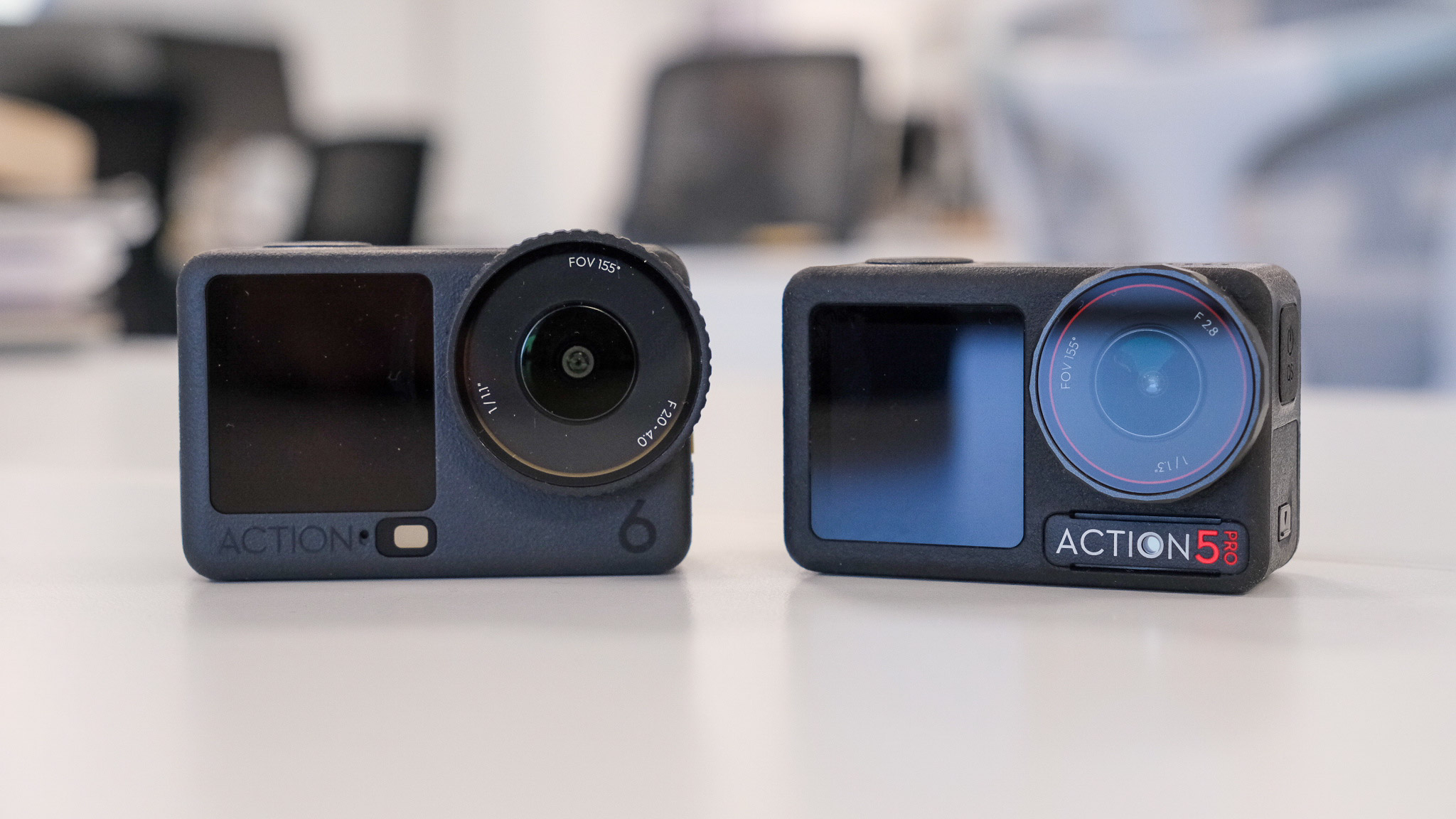

When the DJI Osmo Action 5 Pro launched in late 2024, it positioned itself as the best action camera from the brand yet, a compact, magnetic, creator-friendly device with a large 1/1.3-inch sensor, excellent stabilisation and reliable 4K performance. It became a go-to option for travellers, cyclists, vloggers and anyone who wanted premium image quality without carrying a full camera rig.
Fast-forward 14 months, and the company has unveiled the DJI Osmo Action 6, a noticeably more ambitious successor. The new model is the world’s first action camera with a variable aperture, and it has a larger 1/1.1-inch sensor with up to 13.5 stops of dynamic range, improved cold-weather endurance, smarter audio, faster charging, 50GB of internal storage and a brand-new 4K Custom Mode designed for multi-platform creators.
It also launches at a slightly higher price than the Action 5 Pro did at release. So, is the Action 6 a meaningful upgrade, or is the 5 Pro still worth hanging on to? Let’s break down every key change in DJI’s most advanced compact cameras to date.
DJI Osmo Action 6 vs Action 5 Pro
Price and value for money
At launch, the DJI Osmo Action 5 Pro entered the market as a premium but accessible flagship, priced at around £329 in the UK, €379 in Europe, $349 in the US and approximately AU$599 in Australia.
Fast-forward to now, and the Action 5 Pro is being sold for significantly less than its original RRP. In the UK, it regularly dips to £250–£270, marking a substantial saving over launch and reshaping the conversation around its value.
Equivalent discounts can be found in other regions, with EU prices falling well below the €300 mark, US pricing often landing around $299, and Australian stock coming in notably under AU$500 depending on retailer and availability.

The Osmo Action 6 arrives with more or less the same RRP. The Standard Combo is set at £329 in the UK, €379 in Europe, and expected to land around $379 in the US (if it ever launches there) and AU$649–699 in Australia. Its pricing keeps it in the upper mid-range of the action camera market.
Get all the latest news, reviews, deals and buying guides on gorgeous tech, home and active products from the T3 experts
When considered purely on price, the Action 5 Pro is undeniably cheaper and delivers remarkable value, especially at its current reduced street prices. But when factoring in the leap in capability, longevity, and creative flexibility, the Action 6 offers more per pound (per dollar, per euro) spent, particularly for those who care about image quality and future-proofing.
Both cameras are available via DJI's online store, as well as third-party retailers.
Winner: Tie. The Osmo Action 6 provides better long-term value thanks to its far broader feature upgrade, but for the reduced price, the Action 5 Pro is one of the best value-for-money action cameras right now.
Design and build quality
The DJI Osmo Action 5 Pro and Osmo Action 6 share a familiar design language. The Action 5 Pro has a compact, durable chassis weighing 146g, waterproofing to 20 metres without a case (and 60 metres with one), and dual HDR touchscreens with excellent brightness and colour accuracy.
Its front 1.46-inch display and larger 2.5-inch rear screen are both P3-wide-gamut panels capable of hitting up to 1,000 nits peak – no wonder the Action 6 uses the exact same screen setup. The physical quality of the Action 5 Pro feels premium, solid in hand and when mounted onto helmets or bikes.

Left: Osmo Action 6, Right: Osmo Action 5 Pro
On the other hand, the Osmo Action 6 is slightly heavier at 149 g but has roughly the same physical dimensions (72.8 × 47.2 × 33.1 mm), maintaining the compact footprint of its predecessor while packing in more capability.
DJI has given the new camera a more thermally efficient internal architecture, allowing it to sustain higher frame rates for longer without heat throttling, a subtle but important improvement for anyone shooting 4K or using slow-motion modes.
Waterproofing remains just as strong, with an IP68 rating enabling 20-metre dives without a case. However, the Action 6 adds smarter underwater capabilities thanks to its built-in colour-temperature sensor and dedicated dive data logging. This makes underwater footage look more natural straight out of the camera.
The cold-weather improvements are also significant, with the Action 6 rated for reliable operation down to –20°C, a noticeable step up from older models and a major advantage for skiers, mountaineers and winter trail riders.

They might look the same, but the Action 6 (left) has an updated magnetic mount system
The Action 6 has an updated magnetic mount, allowing you to switch directions without moving the mount itself. The newer model also benefits from accessory compatibility with new add-ons such as the FOV Boost Lens and Macro Lens, both designed to attach to the updated front plate.
Ultimately, both cameras are tough, dependable and well thought out. But the Osmo Action 6 builds on the 5 Pro’s foundation with improved thermal performance, cold-weather resilience, expanded accessory compatibility and smarter underwater imaging.
Winner: the Osmo Action 6 is a stronger, more refined and more adventure-ready evolution of the Action 5 Pro.
Features
The DJI Osmo Action 5 Pro arrived on the scene in 2024 with one of the strongest feature sets of any compact action camera. Its 1/1.3-inch CMOS sensor delivers detailed, dynamic footage, while its 155-degree ultrawide lens maintains impressive clarity.
The camera offers 4K recording at up to 120 fps in 4:3, strong low-light performance through SuperNight mode, and slow-motion performance that holds up even in demanding conditions. It includes Hyperlapse, Timelapse and Subject Tracking.
Importantly, the Action 5 Pro also features a colour-temperature sensor built into the front plate, enabling better underwater colour reproduction straight out of the camera. And crucially, it uses the same stabilisation algorithms later carried over into the Action 6: RockSteady 3.0, RockSteady 3.0+, HorizonBalancing and HorizonSteady.
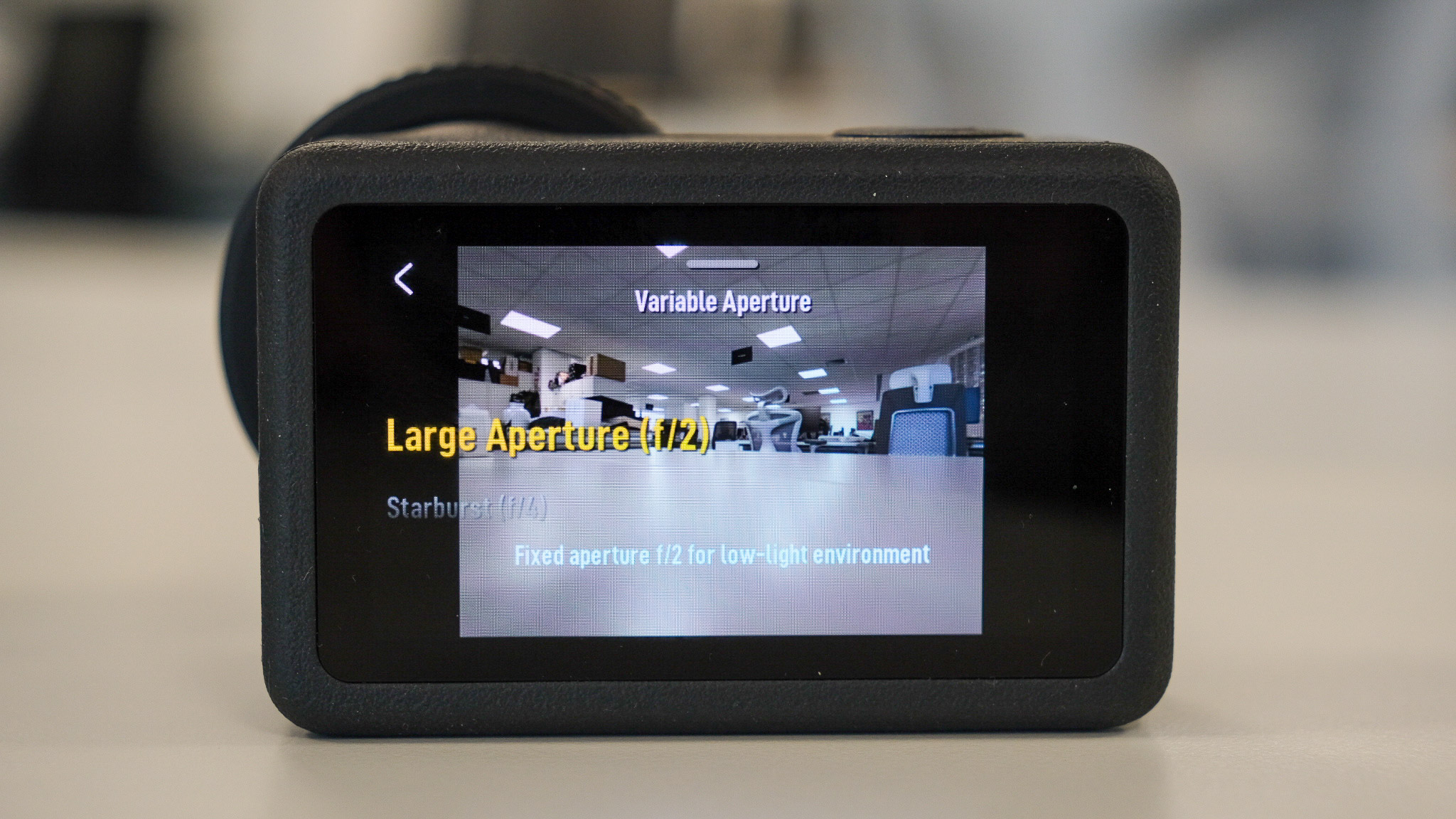
Variable aperture is new to DJI and action cameras in general
The Osmo Action 6’s most notable upgrade is its variable aperture system, the first of its kind on an action camera, which lets you dynamically switch between f/2.0 and f/4.0. This enables stronger low-light performance and the option for creative shallow depth-of-field effects when using the Macro Lens accessory (although the minimal focusing distance is 20cm, so don’t expect miracles).
The new 1/1.1-inch square sensor expands dynamic range to a claimed 13.5 stops, improving highlight retention and shadow detail. DJI’s new 4K Custom Mode also debuts here, letting users shoot once and crop later into vertical, horizontal or square formats, a major workflow advantage for multi-platform creators.
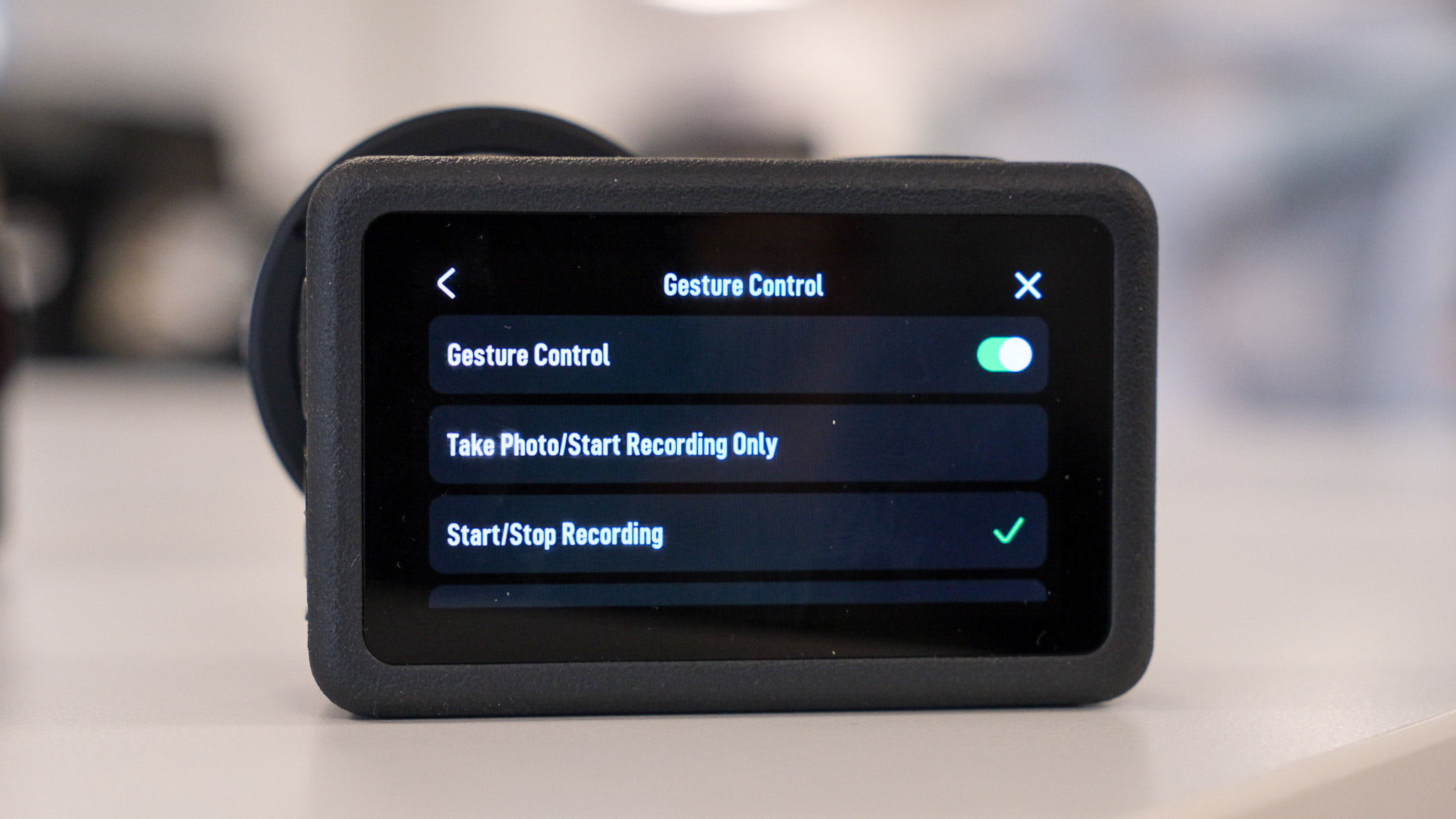
The Action 6 adds gesture control
While the Action 5 Pro already offered strong stabilisation, the Action 6 refines subject tracking behaviour and introduces gesture control (ala Insta360 Ace Pro 2), making hands-free operation far easier. The audio system is also expanded, with support for dual direct DJI mic transmitters without needing a receiver, perfect for interviews, two-person vlogs or capturing ambient sound alongside narration.
The Action 5 Pro remains one of the most capable action cameras of its generation, but the Action 6 brings several first-time features, superior sensor technology and a more advanced creator ecosystem.
Winner: Osmo Action 6, thanks to its variable aperture, upgraded sensor and multi-platform shooting flexibility.
Battery life and charging
The Action 5 Pro uses a 1,950 mAh battery rated for up to 240 minutes of recording in controlled conditions when shooting at 1080p/24 fps. In general use, especially in higher resolutions like 4K/60 or 4K/120, runtimes drop, but the camera remains reliable for extended sessions.
Charging the Action 5 Pro via USB-C is reasonably quick, though not particularly fast by current standards. Most users will typically carry one or two spare batteries to comfortably cover a day of mixed shooting.
The Osmo Action 6 retains a 1,950 mAh Extreme Battery, but its improved power efficiency, enhanced thermal management and updated processing pipeline allow it to stretch runtimes further.
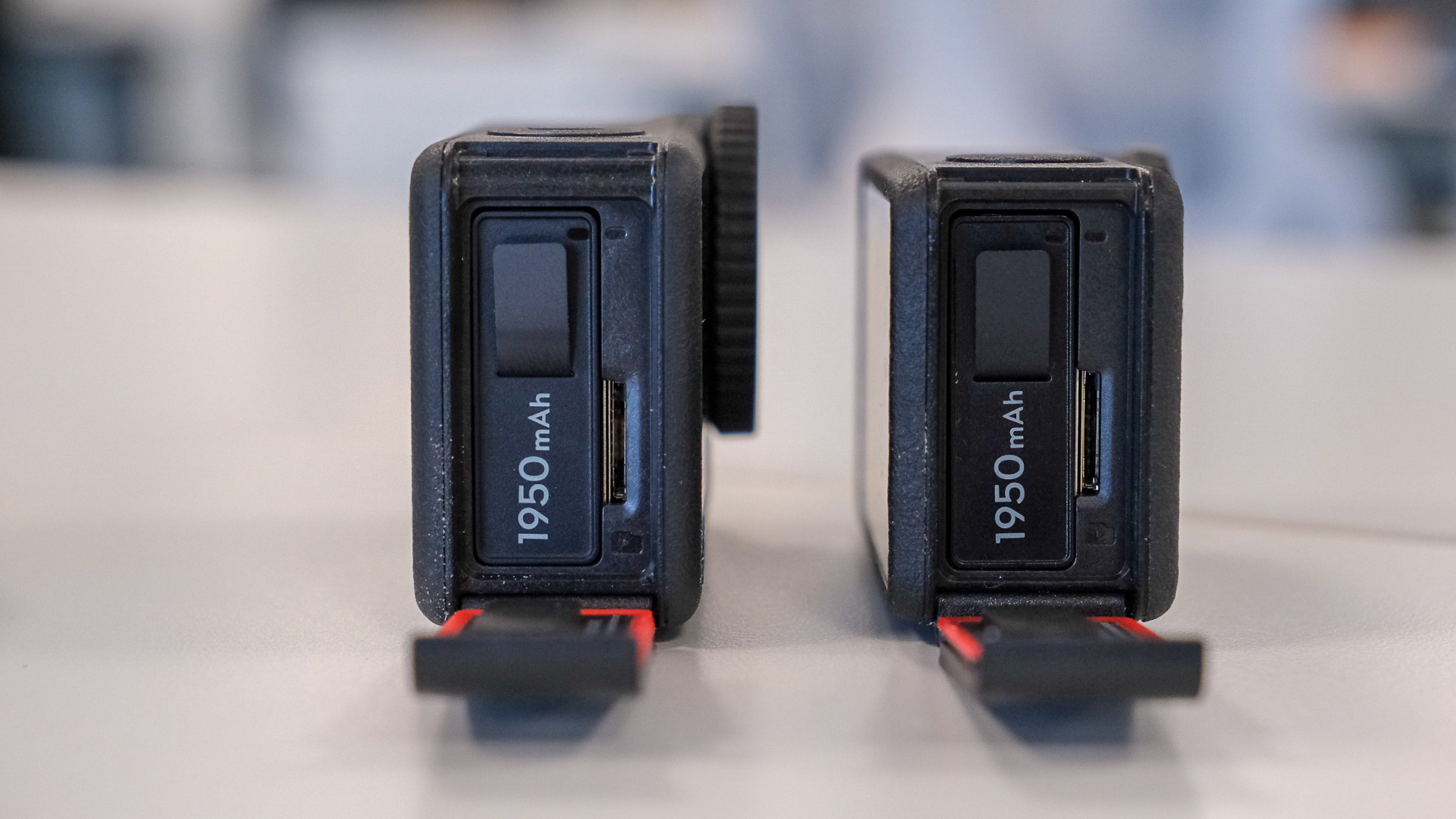
DJI claims up to four hours of continuous shooting in 1080p/24, which matches the Action 5 Pro’s numbers on paper but feels more achievable in real-world use thanks to reduced overheating and better control of internal temperatures.
The biggest upgrade is charging speed: the Action 6 can fast-charge to 80% in around 22 minutes, which is a substantial improvement for creators who need to get back out the door quickly.
While the Action 5 Pro delivers solid longevity and dependable cold-weather behaviour, the Osmo Action 6’s faster charging, more efficient operation and superior thermal stability give it a noticeable advantage for demanding creators.
Winner: Tie. The Osmo Action 6 introduces some updates, most notably faster charging speeds, but overall, both cameras last more than long enough on a single charge.
Storage and connectivity
The Action 5 Pro includes 64GB of internal storage, with around 47GB usable, which is super practical for shooting when you forget a microSD card or need overflow space during longer sessions.
It supports microSD cards up to 1TB, and its combination of Wi-Fi 6 and Bluetooth 5.1 enables quick, reliable wireless transfers. Connectivity is otherwise straightforward: you have standard USB-C for data and charging, plus support for external microphones via compatible adapters.
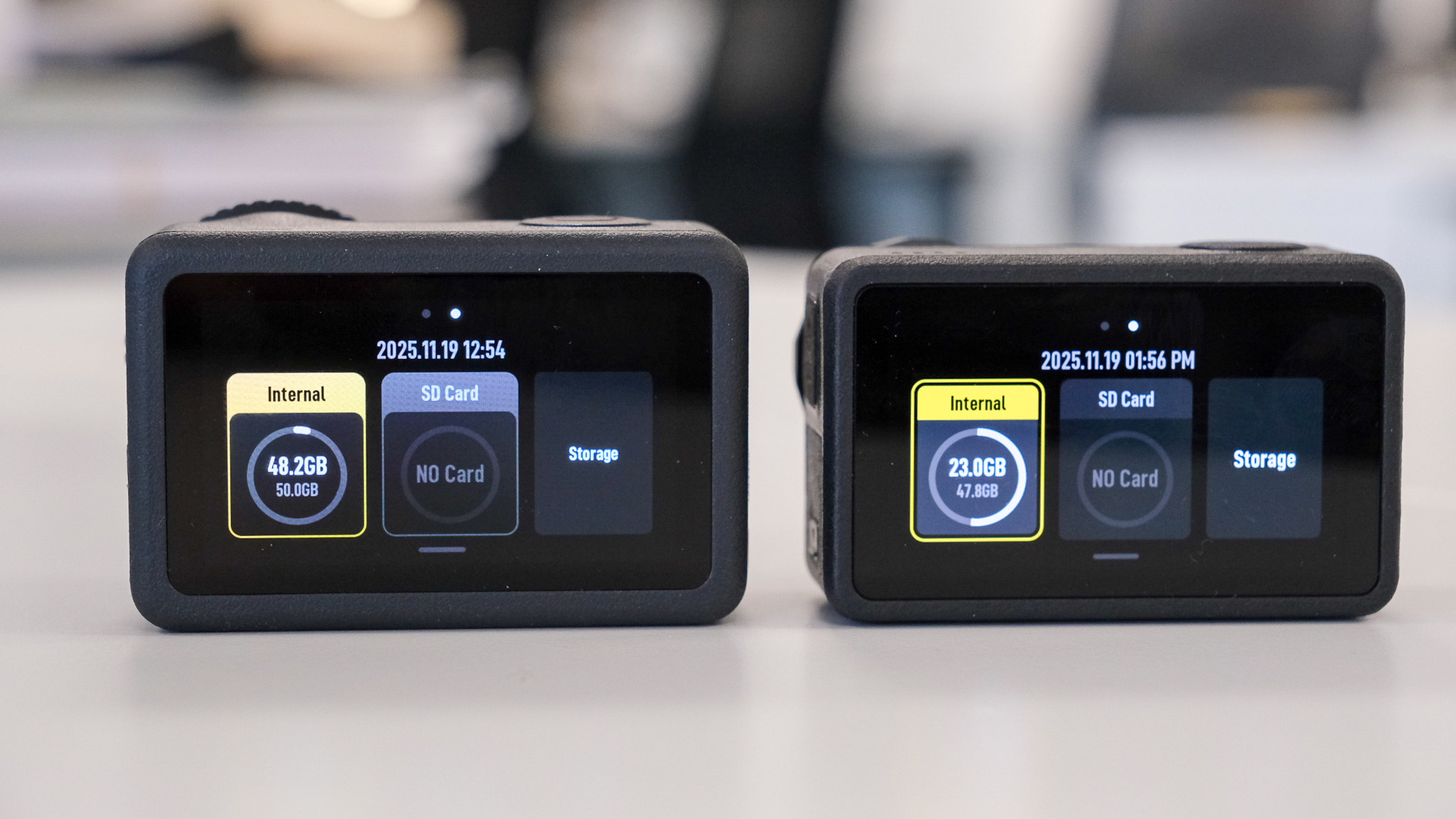
The Action 6 has a slightly larger internal storage
The Osmo Action 6 has 50GB of internal storage, still enough for 4K recording when shooting without a card. Where the Action 6 clearly pulls ahead is audio and wireless integration: it supports direct connection to two DJI mic transmitters without a receiver, making it a stronger choice for interviews, moto vlogging, travel content and multi-person recordings.
Winner: Tie. The Action 6 introduces some improvements, but the Action 5 Pro is still more than capable enough in most use cases.
Verdict
The DJI Osmo Action 6 is a genuinely more capable camera in almost every meaningful area. The introduction of a variable aperture opens up creative possibilities that simply didn’t exist on any action camera before it.
The new 1/1.1-inch sensor delivers richer dynamic range, cleaner shadows and more natural highlight roll-off. Faster charging, more reliable cold-weather behaviour and direct dual-mic support all contribute to a camera that feels dramatically more versatile, more polished and more “pro-ready” than its predecessor.

However, the Osmo Action 5 Pro remains far from obsolete. Its price drop alone makes it one of the best value-for-money action cameras available today. Its image quality is still excellent, its stabilisation performance holds up against newer models, and its 47GB of usable internal storage is a rare convenience.
For most non-professional users, including travellers, commuters, cyclists and vloggers who want a dependable camera without stretching their budget, the Action 5 Pro remains an incredibly sensible buy. In day-to-day use, it still delivers the core DJI experience: reliable footage, flexible shooting modes, strong stabilisation and a compact, rugged build.
For creators who want the very best image quality, regularly shoot in mixed lighting, need a single clip to serve multiple platforms, or rely heavily on wireless audio, the Action 6 is unquestionably worth the upgrade. For everyone else, especially those buying their first DJI model, the Action 5 Pro at its current pricing is still an exceptional piece of kit.
Alternatively, beginner users should also consider the DJI Nano, or a compact action cam from one of the rivals, such as the Insta360 Go 3S or the latest GoPro Hero.

Matt Kollat is a journalist and content creator who works for T3.com and its magazine counterpart as an Active Editor. His areas of expertise include wearables, drones, fitness equipment, nutrition and outdoor gear. He joined T3 in 2019. His byline appears in several publications, including Techradar and Fit&Well, and more. Matt also collaborated with other content creators (e.g. Garage Gym Reviews) and judged many awards, such as the European Specialist Sports Nutrition Alliance's ESSNawards. When he isn't working out, running or cycling, you'll find him roaming the countryside and trying out new podcasting and content creation equipment.
You must confirm your public display name before commenting
Please logout and then login again, you will then be prompted to enter your display name.